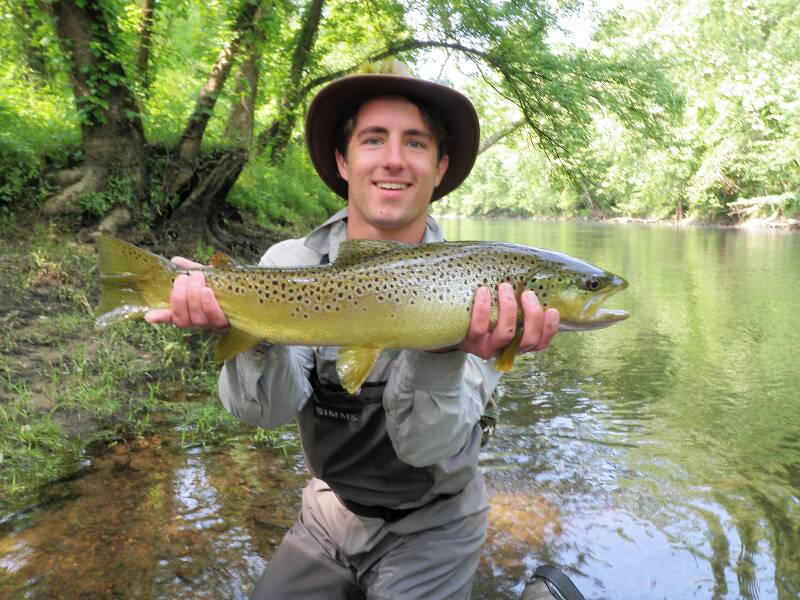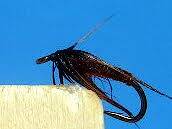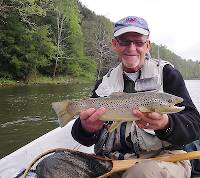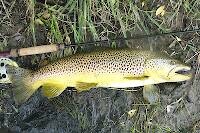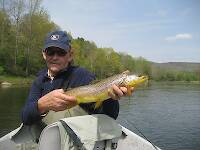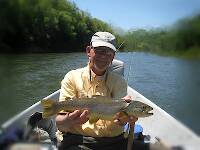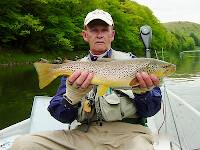
Blue-winged Olives
Baetis
Tiny Baetis mayflies are perhaps the most commonly encountered and imitated by anglers on all American trout streams due to their great abundance, widespread distribution, and trout-friendly emergence habits.
Featured on the forum
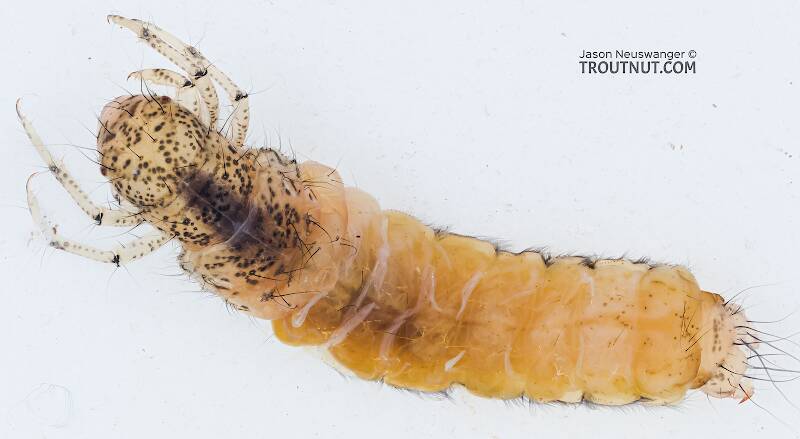
This is a striking caddis larva with an interesting color pattern on the head. Here are some characteristics I was able to see under the microscope, but could not easily expose for a picture:
- The prosternal horn is present.
- The mandible is clearly toothed, not formed into a uniform scraper blade.
- The seems to be only 2 major setae on the ventral edge of the hind femur.
- Chloride epithelia seem to be absent from the dorsal side of any abdominal segments.
Based on these characteristics and the ones more easily visible from the pictures, this seems to be Grammotaulius. The key's description of the case is spot-on: "Case cylindrical, made of longitudinally arranged sedge or similar leaves," as is the description of the markings on the head, "Dorsum of head light brownish yellow with numerous discrete, small, dark spots." The spot pattern on the head is a very good match to figure 19.312 of Merritt R.W., Cummins, K.W., and Berg, M.B. (2019). The species ID is based on Grammotaulius betteni being the only species of this genus known in Washington state.
- The prosternal horn is present.
- The mandible is clearly toothed, not formed into a uniform scraper blade.
- The seems to be only 2 major setae on the ventral edge of the hind femur.
- Chloride epithelia seem to be absent from the dorsal side of any abdominal segments.
Based on these characteristics and the ones more easily visible from the pictures, this seems to be Grammotaulius. The key's description of the case is spot-on: "Case cylindrical, made of longitudinally arranged sedge or similar leaves," as is the description of the markings on the head, "Dorsum of head light brownish yellow with numerous discrete, small, dark spots." The spot pattern on the head is a very good match to figure 19.312 of Merritt R.W., Cummins, K.W., and Berg, M.B. (2019). The species ID is based on Grammotaulius betteni being the only species of this genus known in Washington state.

Troutnut is a project started in 2003 by salmonid ecologist Jason "Troutnut" Neuswanger to help anglers and
fly tyers unabashedly embrace the entomological side of the sport. Learn more about Troutnut or
support the project for an enhanced experience here.
Sayfu
Posts: 560
Posts: 560
Sayfu on Sep 30, 2012September 30th, 2012, 5:58 am EDT
Jesse, Gotcha. I read your post wrong.
Jesse on Oct 5, 2012October 5th, 2012, 5:30 pm EDT
Hey Paul why is that? Because of the energy in preparation and the lack of once the spawning process is complete? Thanks man.
Most of us fish our whole lives..not knowing its not the fish that we are after.
http://www.filingoflyfishing.com
http://www.filingoflyfishing.com
Entoman on Oct 6, 2012October 6th, 2012, 3:16 am EDT
I assume because they start to get aggressive before and then hungry afterwards - but I may be engaging in a little anthropomorphism here. :)
"It's not that I find fishing so important, it's just that I find all other endeavors of Man equally unimportant... And not nearly as much fun!" Robert Traver, Anatomy of a Fisherman
Sayfu
Posts: 560
Posts: 560
Sayfu on Oct 6, 2012October 6th, 2012, 5:56 am EDT
I'll buy Entoman's assessment. Spawning fish prior to do get very aggressive especially the males. I've substituted a lot in the high schools and the males do the same thing in the Spring.
PaulRoberts on Oct 6, 2012October 6th, 2012, 8:51 am EDT
Kurt said it concisely. Nothing anthropomorphic there -even non-human animals show aggression and hunger. In between -during the spawning act- they are preoccupied , simply busy. I think we can understand that too.
Oldredbarn on Oct 7, 2012October 7th, 2012, 7:50 am EDT
Kurt said it concisely. Nothing anthropomorphic there -even non-human animals show aggression and hunger. In between -during the spawning act- they are preoccupied , simply busy. I think we can understand that too.
Paul...How about just anthropology? I spent (mis-spent) last Friday night in the middle of no-where at an old rowdy roadhouse listening to Whitey Morgan and the 78's...One of those places where once the band starts they stop surving beer in bottles or glasses...Don't want anyone to get hurt. :)
Wonderful band...
But to stay on topic...I was getting pretty hungry myself just watching them good-old-boys displaying to the girls on the dance floor...By the end of the evening they must of been famished themselves...:)
I'm atoning for my night of rowdiness by excorting my niece out to Kalamazoo tomorrow to visit K-College...This is the last "walk-through"...She stayed with us this weekend and sat for her SAT Saturday morning early...Luckily the wife made sure she got there on time and I slept through until we had to pick her up.
I can't hang like I used to...Those younger bucks had way more energy than me. I'm just showing up as a non-participating observer at these things now-a-days...Mostly there for the tunes.
Spence
"Even when my best efforts fail it's a satisfying challenge, and that, after all, is the essence of fly fishing." -Chauncy Lively
"Envy not the man who lives beside the river, but the man the river flows through." Joseph T Heywood
"Envy not the man who lives beside the river, but the man the river flows through." Joseph T Heywood
PaulRoberts on Oct 7, 2012October 7th, 2012, 9:51 am EDT
Well Spence, I think I can almost bring even THAT post back on topic ...
There are male trout, usually smaller than those spawning, that participate in the spawn by lying in wait below the spawning pair, then shooting in at any opportune moment and releasing sperm into the redd. An inopportune moment means the little bugger receives a severe bite from the one or more tending males. In the fisheries literature the published term for those little sneakers is "Sneaky F***ers". No kidding.
When fishing during the spawn, and you spot a spawning pair, it always pays to fish any cuts or cover immediately below the redd. There lie the Sneaky F***ers" and often a few Greedy Egg Suckers" and "Wannabe Doin It Too Hens" too. Back when I did such fishing I've caught as many as 6 fish at one redd -fish you don't normally see and just have to know are likely there.
Sorta like you propped in that chair in the back of that dive, just watching. And no I'm not calling you names, but I couldn't resist sweeping your post back on topic. :)
There are male trout, usually smaller than those spawning, that participate in the spawn by lying in wait below the spawning pair, then shooting in at any opportune moment and releasing sperm into the redd. An inopportune moment means the little bugger receives a severe bite from the one or more tending males. In the fisheries literature the published term for those little sneakers is "Sneaky F***ers". No kidding.
When fishing during the spawn, and you spot a spawning pair, it always pays to fish any cuts or cover immediately below the redd. There lie the Sneaky F***ers" and often a few Greedy Egg Suckers" and "Wannabe Doin It Too Hens" too. Back when I did such fishing I've caught as many as 6 fish at one redd -fish you don't normally see and just have to know are likely there.
Sorta like you propped in that chair in the back of that dive, just watching. And no I'm not calling you names, but I couldn't resist sweeping your post back on topic. :)
Entoman on Oct 7, 2012October 7th, 2012, 1:08 pm EDT
Ha! That's the way of nature. From little forked horns that sneak in on the harem while the big bucks are fighting over it to the low level court attendee sneaking into the princess chambers... It's a fact that the little guys are often the ones that do most of the breeding, though they often pay for it dearly when caught...:)LOL
The old decrepit ones are handled a bit differently as they are usually separated out from the herd and have to watch the goings-on from the sidelines, usually at some distance... Spence?
The old decrepit ones are handled a bit differently as they are usually separated out from the herd and have to watch the goings-on from the sidelines, usually at some distance... Spence?
"It's not that I find fishing so important, it's just that I find all other endeavors of Man equally unimportant... And not nearly as much fun!" Robert Traver, Anatomy of a Fisherman
Oldredbarn on Oct 7, 2012October 7th, 2012, 2:49 pm EDT
Paul, Kurt,
You two are wonderful! I'm laughing my ass off here...:)
Spence
You two are wonderful! I'm laughing my ass off here...:)
Spence
"Even when my best efforts fail it's a satisfying challenge, and that, after all, is the essence of fly fishing." -Chauncy Lively
"Envy not the man who lives beside the river, but the man the river flows through." Joseph T Heywood
"Envy not the man who lives beside the river, but the man the river flows through." Joseph T Heywood
PaulRoberts on Oct 9, 2012October 9th, 2012, 9:00 am EDT
I'll add this web page this thread as well, since their is a lot of good info on brown spawning in it:
http://canadianangling.com/hatchery-river-restoration/
http://canadianangling.com/hatchery-river-restoration/
Jesse on Oct 11, 2012October 11th, 2012, 4:38 pm EDT
But what about fishes health? I'm particularly asking about when it's least damaging to the fish as far as catching them during the pre, post, or during spawn?
Most of us fish our whole lives..not knowing its not the fish that we are after.
http://www.filingoflyfishing.com
http://www.filingoflyfishing.com
PaulRoberts on Oct 11, 2012October 11th, 2012, 5:31 pm EDT
Ah! Post spawn. Hand's down. Trout go through hell during the spawn and they can get really run down following; Many don't survive. Some years, and waters, are worse than others in this regard.
Cold water of early winter (when browns are in post spawn) helps in terms of 02 and infections. You have to judge the health of the fish as you catch them and decide if what you are doing is OK. Judge how quickly they recoup after capture. If they are weak, you may be better off leaving them be, even though they are taking well.
Cold water of early winter (when browns are in post spawn) helps in terms of 02 and infections. You have to judge the health of the fish as you catch them and decide if what you are doing is OK. Judge how quickly they recoup after capture. If they are weak, you may be better off leaving them be, even though they are taking well.
DUBBN on Oct 14, 2012October 14th, 2012, 5:23 am EDT
I'll add this web page this thread as well, since their is a lot of good info on brown spawning in it:
http://canadianangling.com/hatchery-river-restoration/
Thank you for that link. The information in that article was amazing. I was quite surprised to learn that the color of a trouts eggs can be dictated by what it eats. Makes sense. A chicken will get darker yolks if allowed to free range, and has access to greens (Hay, alfalfa, grass, Dandylions). Still, I would never made the connection between a bird and a fish and the pigment of their eggs on my own.
Female Brown trout laying in another females redd (nest). I had no idea about that either.
The introduction of the Brown trout to N.America I found interesting as well. As a kid, the Brown Trout were refered to as "German Browns". I assumed (incorrectly) that most Browns were imported from Germany. I had no idea there were so many "familys" of Browns. It seems to me that the Brown populations of N. America mirror the human population as "The Great Melting Pot."
I wonder. Were the Browns that were introduced to other continents and countries, inner bred as much as the Browns of N. America?
Again Mr. Roberts, that was a fascinating read. Thank you.
It's OK to disagree with me. I can not force you to be right.
PaulRoberts on Oct 15, 2012October 15th, 2012, 8:10 am EDT
I wonder. Were the Browns that were introduced to other continents and countries, inner bred as much as the Browns of N. America?
The whole world is becoming a melting pot. I don't know about stocking in other countries. But hatcheries are not new. In much of the world hatcheries are for fish farming though.
Reminds me of the birding I did while in China. As I got familiar with local bird life I began to see things that shouldn't be in my location, and then became hip to the wild bird trade that has a strong following there. The idea is to purchase wild birds at a bird market (some of these market areas are very large) keep them for a time and then let them go.
There are very few places now that haven't been greatly affected by human play.
Jmd123 on Oct 15, 2012October 15th, 2012, 6:27 pm EDT
DUBBN and other fellow troutnuts, check out James Prosek's book, Trout of the World (ISBN 1-58479-152-7). He has illustrated an AMAZING variety of brown trout subspecies from Europe and Asia, and this will give you some idea of the genetic diversity in this species. I also have his book, Trout - An Illustrated History, which covers the salmonids of North America and also wonderfully illustrates, in full watercolors, the diveristy we have here on this continent, especially of subspecies of cutthroat trout. Highly recommended reading for anyone who loves trout and their kin!
Jonathon
P.S. Trout of the World even comes with a poster!
Jonathon
P.S. Trout of the World even comes with a poster!
No matter how big the one you just caught is, there's always a bigger one out there somewhere...
Entoman on Oct 15, 2012October 15th, 2012, 10:02 pm EDT
Here's some layman's definitions of the terms used in this thread that might prove helpful for our conversation (biologists please forgive the technical generalities and over-simplification:)):
Race or strain - populations within a species (or even subspecies) exhibiting characters at variance with other populations, usually due to geographic isolation.
Subspecies - a population whose variation is more distinct than race or strain and can even have races or strains within them.
Species - organisms capable of producing fertile offspring. May or may not contain subspecies.
Interbreeding - breeding between different strains or subspecies that produce fertile offspring or breeding between closely related species that produce infertile offspring (mules). We are only concerned with the former unless we expand the conversation to include tiger trout.
Inbreeding - breeding between individuals within a strain or subspecies. Also refers to the extreme where mates are so closely related that pathologies begin to surface.
Hybrid - A mix of strains or subspecies. Distinctions quickly dissipate within the gene pool once strains are removed from their isolation and allowed to mix with others and interbreed.
Now for a few ideas I'd like to contribute:
a. How biologists decide whether a given population is a species, strain of species, a subspecies, or even a strain of subspecies is a fascinating topic worthy of its own thread. What is relevant to mention here is the fact that biologists have historically moved populations of brown trout around a lot within these classifications. This is primarily due to increased knowledge of the characters involved as time goes by, but also due to differing hypothetical concepts of "species" in vogue along the way. This inevitably leads to confusion among us anglers, depending on which (usually dated) sources we are referencing. Suffice to say for our purposes if it has a three word Latin name, it's a subspecies.:)
b. Currently, there aren't different recognized species linked with the common name "brown trout", but there are quite a few sub-species and a lot of strains. All brown trout are Salmo trutta. With a very high degree of probability, all North American browns are pure Salmo trutta trutta, a subspecies aka North European brown trout.
c. While it is true that other strains of t. trutta have undoubtedly been introduced, I believe I'm right in saying most of the genes come from two strains of German origin delivered to us by Baron von Behr and a strain from Loch Leven, Scotland - both shipped over in the late 19th century. Though some of these undoubtedly exist in isolated populations around the country and thus remain "purebreds", the vast majority of our browns are hybrids. Habitat also has a tremendous influence on coloration (as well as other more significant characters) and it is probably true that adaptions to our environs are evolving new "strains" as well. However, the old rule of thumb that the "somber ones with few if any red spots are more Loch Leven, while the brilliant colored ones with red spots, blue halos and lots of yellow are mostly German brown" still has some validity.
d. I'm not aware of any scientific basis for determining between wild vs. holdover planters based on spot patterns. Even so, it can't be denied that astute local anglers have no problem telling the difference between a region's wild strains and planters from a particular hatchery that may have been recently introduced. Especially if the differences are dramatic. My suspicion is it wouldn't take long for such distinctions to disappear though - if the plantings were to continue. BTW - planting browns in habitats where unique "strains" of American browns are beginning to develop is a very bad idea IMO.
Race or strain - populations within a species (or even subspecies) exhibiting characters at variance with other populations, usually due to geographic isolation.
Subspecies - a population whose variation is more distinct than race or strain and can even have races or strains within them.
Species - organisms capable of producing fertile offspring. May or may not contain subspecies.
Interbreeding - breeding between different strains or subspecies that produce fertile offspring or breeding between closely related species that produce infertile offspring (mules). We are only concerned with the former unless we expand the conversation to include tiger trout.
Inbreeding - breeding between individuals within a strain or subspecies. Also refers to the extreme where mates are so closely related that pathologies begin to surface.
Hybrid - A mix of strains or subspecies. Distinctions quickly dissipate within the gene pool once strains are removed from their isolation and allowed to mix with others and interbreed.
Now for a few ideas I'd like to contribute:
a. How biologists decide whether a given population is a species, strain of species, a subspecies, or even a strain of subspecies is a fascinating topic worthy of its own thread. What is relevant to mention here is the fact that biologists have historically moved populations of brown trout around a lot within these classifications. This is primarily due to increased knowledge of the characters involved as time goes by, but also due to differing hypothetical concepts of "species" in vogue along the way. This inevitably leads to confusion among us anglers, depending on which (usually dated) sources we are referencing. Suffice to say for our purposes if it has a three word Latin name, it's a subspecies.:)
b. Currently, there aren't different recognized species linked with the common name "brown trout", but there are quite a few sub-species and a lot of strains. All brown trout are Salmo trutta. With a very high degree of probability, all North American browns are pure Salmo trutta trutta, a subspecies aka North European brown trout.
c. While it is true that other strains of t. trutta have undoubtedly been introduced, I believe I'm right in saying most of the genes come from two strains of German origin delivered to us by Baron von Behr and a strain from Loch Leven, Scotland - both shipped over in the late 19th century. Though some of these undoubtedly exist in isolated populations around the country and thus remain "purebreds", the vast majority of our browns are hybrids. Habitat also has a tremendous influence on coloration (as well as other more significant characters) and it is probably true that adaptions to our environs are evolving new "strains" as well. However, the old rule of thumb that the "somber ones with few if any red spots are more Loch Leven, while the brilliant colored ones with red spots, blue halos and lots of yellow are mostly German brown" still has some validity.
d. I'm not aware of any scientific basis for determining between wild vs. holdover planters based on spot patterns. Even so, it can't be denied that astute local anglers have no problem telling the difference between a region's wild strains and planters from a particular hatchery that may have been recently introduced. Especially if the differences are dramatic. My suspicion is it wouldn't take long for such distinctions to disappear though - if the plantings were to continue. BTW - planting browns in habitats where unique "strains" of American browns are beginning to develop is a very bad idea IMO.
"It's not that I find fishing so important, it's just that I find all other endeavors of Man equally unimportant... And not nearly as much fun!" Robert Traver, Anatomy of a Fisherman
PaulRoberts on Oct 16, 2012October 16th, 2012, 9:34 am EDT
Excellent synopsis, Kurt.
Entoman on Oct 16, 2012October 16th, 2012, 10:57 am EDT
Thanks, Paul. Just hoping to continue the discussion while putting up some term explanations in case we've been confusing readers. I struggled with which thread to put this on as we have two running concurrently that touch on this topic peripherally. In retrospect, I probably should have started a new thread... Oh well, too late now! :)
"It's not that I find fishing so important, it's just that I find all other endeavors of Man equally unimportant... And not nearly as much fun!" Robert Traver, Anatomy of a Fisherman
Quick Reply
Related Discussions
Topic
Replies
Last Reply
10
Feb 24, 2010
by CaseyP
by CaseyP


